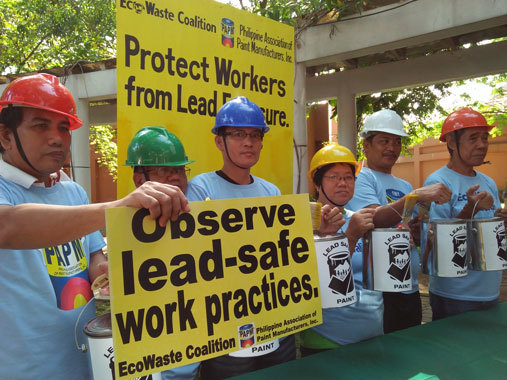More news
- Asian paint regulatory round up – Indonesian exterior paint still uses lead, warns W...
- Nigeria’s paint industry navigates regulatory changes and economic challenges amid p...
- Focus on the global coatings market: Global coatings market outlook
- Ask Joe Powder – October 2024
- Chinese paint majors look to domestic consumer sales as commercial real estate slumps

Groups at the forefront of the Philippine’s efforts to make all paints safe from lead, a hazardous chemical, have affirmed their unity to promote compliance to the national phase-out target for lead-added industrial paints by December 31, 2019
The Philippine Association of Paint Manufacturers (PAPM) and the EcoWaste Coalition made the affirmation through a joint statement to mark the fifth anniversary of the trailblazing Department of Environment and Natural Resources (DENR) Administrative Order No 2013-24, issued on December 23, 2013.
Also known as the Chemical Control Order for Lead and Lead Compounds, the said policy directs the phase-out of lead-containing paints used for industrial applications by December 31, 2019.
"After completing the phase-out of lead-containing architectural, household and decorative paints last December 31, 2018, paint makers are now setting their sights on meeting the phase-out target for paints intended for industrial applications that still contain lead additives,” said Vergel Dyoco, Technical Committee Chairman of PAPM and Technical Service Department Manager, Pacific Paint (Boysen) Philippines, Inc.
"Our paint manufacturers are investing resources to find feasible replacements to lead-based raw materials in order to abide by the 2019 deadline for phasing out lead-added paints used for cars, aircrafts, boats, appliances, metal sheets and other industrial uses,” he said.
"The completion by December 2019 of the phase-out goal for lead-containing industrial paints will be an historic milestone in our common mission to eliminate lead paint, a preventable source of childhood lead exposure, in all paint categories,” said Manny Calonzo, Adviser, EcoWaste Coalition.
"The world will be watching as the Philippine paint industry transitions to full lead-safe paint production by 2020, a meaningful achievement that we all can be proud of because of its tremendous benefits to human health as well as to the economy,” he added.
As stated in a 2018 resource pack published by the World Health Organization, United Nations Environment and the Global Alliance to Eliminate Lead Paint (Lead Paint Alliance): "Lead is especially dangerous to children’s developing brains, and can cause reduced intelligence quotient (IQ) and attention span, impaired learning ability, and increased risk of behavioral problems.
"These health impacts also have significant economic costs to countries.”
As explained by the Lead Paint Alliance, which includes the DENR, PAPM, Pacific Paint (Boysen), EcoWaste Coalition and IPEN (a global NGO network campaigning for a toxics-free future) among its partners: "The weathering, peeling or chipping of old lead paint releases lead into dust and soil, in and around homes, schools and other locations.
"Dust contaminated with lead can also be brought into the home on the clothes of those who work in industries where such dust is generated, including paint factories where lead continues to be used.
"Lead-contaminated soil and dust are easily ingested and absorbed, particularly by young children when they play on the floor or outdoors and put their hands or objects in their mouths.
"Children also ingest lead if they mouth and chew toys painted with lead paint,” the alliance said.
Children, as well as adults, can be exposed to lead in paint chips and dust generated during the removal of old paint; hence the need to popularise and observe lead-safe work practices, the PAPM and EcoWaste Coalition pointed out.
Health risks to children, pregnant women and workers can be prevented by making and using paints with no lead additives and adhering to lead-safe work practices, the groups jointly emphasised.



